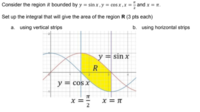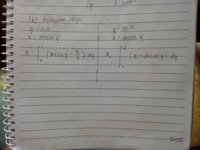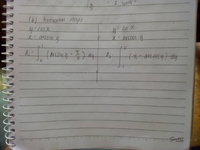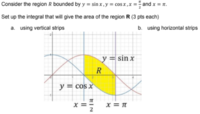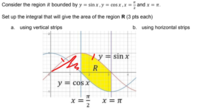So this question has been bugging me for several hours now. The problem is really simple until my prof wants me to find the area of the attached curve using HORIZONTAL STRIPS. Is it even possible to use horizontal strips in this type of curve? Can you guys help me out on how to approach this? Thank you very much!
You are using an out of date browser. It may not display this or other websites correctly.
You should upgrade or use an alternative browser.
You should upgrade or use an alternative browser.
Area Under a Curve
- Thread starter sandi2001
- Start date
Dr.Peterson
Elite Member
- Joined
- Nov 12, 2017
- Messages
- 16,873
Sure, it's possible (though obviously not one's first choice). Just split the region into two parts (which look like they'll be equal), above and below the x-axis. Then you'll be using inverse trig functions.So this question has been bugging me for several hours now. The problem is really simple until my prof wants me to find the area of the attached curve using HORIZONTAL STRIPS. Is it even possible to use horizontal strips in this type of curve? Can you guys help me out on how to approach this? Thank you very much!
Show us your work, so we can see if you're getting off to a bad start.
HallsofIvy
Elite Member
- Joined
- Jan 27, 2012
- Messages
- 7,760
For horizontal strips, you will need to do it as two separate regions.
For y> 0 a horizontal strip will go from x= pi/2 to x= arcsin(y).
For y< 0 a horizontal strip will go from x= arccos(x) to pi.
For y> 0 a horizontal strip will go from x= pi/2 to x= arcsin(y).
For y< 0 a horizontal strip will go from x= arccos(x) to pi.
Sure, it's possible (though obviously not one's first choice). Just split the region into two parts (which look like they'll be equal), above and below the x-axis. Then you'll be using inverse trig functions.
Show us your work, so we can see if you're getting off to a bad start.
Please let me know where I came off wrong. I'm really confused.
Attachments
For horizontal strips, you will need to do it as two separate regions.
For y> 0 a horizontal strip will go from x= pi/2 to x= arcsin(y).
For y< 0 a horizontal strip will go from x= arccos(x) to pi.
Hello, HallsofIvy. Is this what you meant by the parameters? I'm really confused on how to use them. Should I use the parameters on the upper and lower bounds of the integral?
Attachments
Dr.Peterson
Elite Member
- Joined
- Nov 12, 2017
- Messages
- 16,873
View attachment 23623
View attachment 23622
There's one little problem: the range of arcsin is -pi/2 to pi/2, and your x has to be between pi/2 and pi. How can you adjust?
(Halls seems to have missed this; I probably would have, too, in giving a quick suggestion and expecting you to fill in any gaps.)
Can I turn A1 into pi/2 - arcsiny?
Steven G
Elite Member
- Joined
- Dec 30, 2014
- Messages
- 14,603
For A1 y goes from 0 to 1. That part is clear to you based on the your limits in your integral.
Now as pointed out by Dr Peterson, arcsin is defined between -pi/2 and pi/2. Since our y value is between 0 and 1 then the x is between 0 and pi/2. Is there another region of the graph that has x between 0 and pi/2 AND has the same area that you want?? The answer is yes. Just look at the graph and you'll see it.
Same thing for A2
Now as pointed out by Dr Peterson, arcsin is defined between -pi/2 and pi/2. Since our y value is between 0 and 1 then the x is between 0 and pi/2. Is there another region of the graph that has x between 0 and pi/2 AND has the same area that you want?? The answer is yes. Just look at the graph and you'll see it.
Same thing for A2
Dr.Peterson
Elite Member
- Joined
- Nov 12, 2017
- Messages
- 16,873
I would define the inverse function in that region as pi - arcsin(y), which is how we find the angle in the second quadrant with sine y. That leads to exactly what you came out with.Can I turn A1 into pi/2 - arcsiny?

